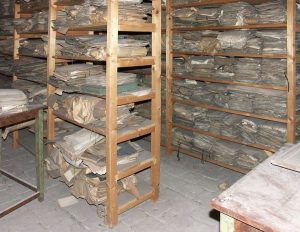 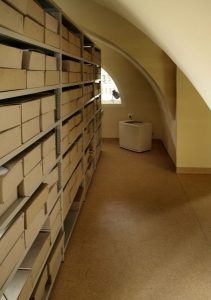
The Archives of Tschammer – before and after the renovation |
 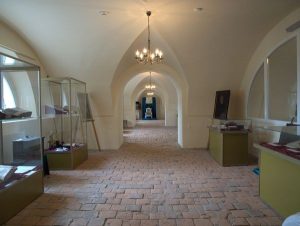 The Museum of Protestantism in Cieszyn Silesia – before and after the renovation The Museum of Protestantism in Cieszyn Silesia – before and after the renovation
|
The Library and Archives of the Brothers Hospitallers needed less work. Owing to the renovation of the entire monastery complex during the previous decade, all that was left to do in the rooms occupied by the library, archives and library workshop was to fit additional internal windows, renovate the parquet floor, install an alarm system and paint the walls – but above all to provide thermohygrographs and mobile air conditioning equipment.
As in the Lutheran church, the historical nature of the building precluded the installation of a central air conditioning, or even wall-mounted air conditioning.
During the project, the monastery’s library and archives were supplied with new library furniture, constructed of solid wood, based on a design by an interior decorator, giving the library and archives a suitably representative character. |
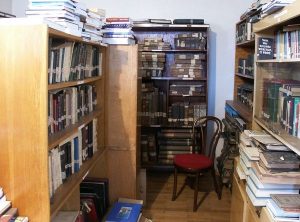 
The Archive and Library of the Merciful Brothers’ Order Convent – before and after the renovation |
In addition, the recent renovation of the Museum of Cieszyn Silesia meant that the rooms where the museum’s library are kept needed only a minor investment, limited to replacing the windows and doors, the installation of a fire and security system, the walls being painted and the equipping of mobile shelving.
The Cieszyn Branch of the State Archives, housed in Książnica Cieszyńska, needed the least work. As part of the project, the archives’ rooms were equipped with an installation for controlling entry and CCTV, as well as an electronic system for monitoring temperature and humidity.
While the archives’ collection was at the Katowice headquarters in order to be cleaned and disinfected, the Cieszyn premises were disinfected and repainted.
|
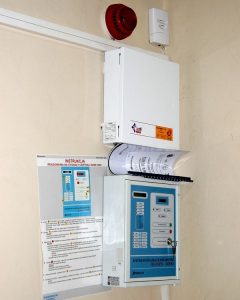 Fire alarm system central unit installed in the Museum. Fire alarm system central unit installed in the Museum.
|
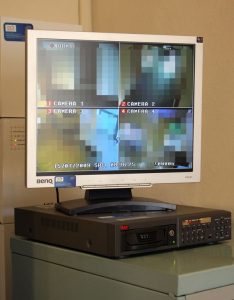 Monitoring of the CCTV cameras installed in the State Archives. Monitoring of the CCTV cameras installed in the State Archives. |
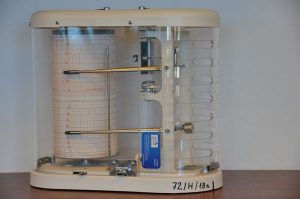 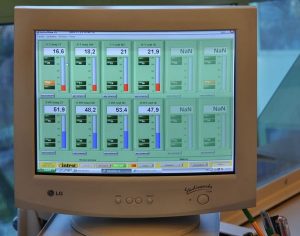 Equipment for climate control monitoring (the photos present the hytherograph and visualization of measurements from the electronic temperature and air humidity monitoring system installed in the Cieszyn Historical Library). Equipment for climate control monitoring (the photos present the hytherograph and visualization of measurements from the electronic temperature and air humidity monitoring system installed in the Cieszyn Historical Library). |
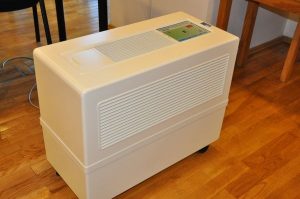 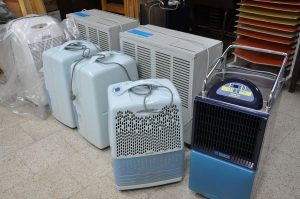  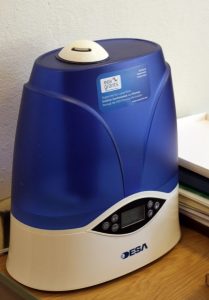 Portable equipment for climate conditioning: dryers, humidifiers and air filters installed in all institutions covered by the project. Portable equipment for climate conditioning: dryers, humidifiers and air filters installed in all institutions covered by the project. |
| In the case of Książnica Cieszyńska itself, the project allowed the completion of the modernisations – mainly concerning equipment – which were planned for the new premises after its opening in 2000, but which could not be carried out owing to cost-cutting at the beginning of the decade. Książnica finalised the installation of an electronic system of temperature and moisture monitoring, replacement of portable dehumidifiers, air dryers and air filters, the purchase of mobile shelving in one of the repositories and display cases – all financed from the project budget. Construction work was also important, involving the insulation and drying- out of the cellars located in the historical part of Książnica Cieszyńska. Owing to these investments, it will prove possible to use the rooms for exhibition purposes, which was planned in the project for the use of the building, but had hitherto been impossible, owing to the high level of humidity. |
 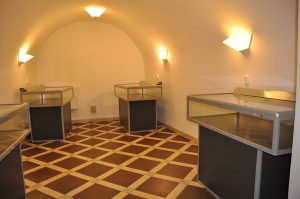
Historical basement in the head office of Cieszyn Historical Library at the stage of drying works and afterwards. |
  The storeroom of Cieszyn Historical Library with old and new racks. The storeroom of Cieszyn Historical Library with old and new racks. |
Książnica Cieszyńska’s efforts regarding the comprehensive care and safeguarding of the collections were focussed on the enlargement and modernisation of the technical infrastructure which would help increase the range of measures carried out by the conservation workshop in the library. The workshop, opened when Książnica Cieszyńska was founded in 1994, was the first fully professional conservation workshop in Upper Silesia. Its equipment – at that time relatively modern and comprehensive – had depreciated over the course of more than a decade, necessitating its replacement by new equipment which met current requirements.
Participation in the project meant that rapid progress could be achieved in that regard. Above all, the worn-out fumigation chamber was replaced by a considerably more cost-efficient, computerised one with a catalytic oxidiser.
Other equipment purchased as part of the project were: a laminator; a laboratory rotary digester; a power paper cutter; a computerised mini-vacuum table and an underlit spotting table, both used in conjunction with an industrial vacuum cleaner; a drying rack and other small items of equipment, such as electronic laboratory scales, a deioniser, a laboratory agitator, a microscope, a light meter etc. The workshop also stocked up with reserves of materials and agents used in the conservation process. All the workshops were equipped with new, fitted furniture.
In keeping with the aims of the project, the modernisation that was carried out to the equipment was supposed to contribute in two ways. It was not only intended to improve the effectiveness of the work carried out by the workshop for the benefit of Książnica Cieszyńska, but also to increase support for the work the other Cieszyn historical libraries would undertake in the future with regard to safeguarding and restoring their collections. |
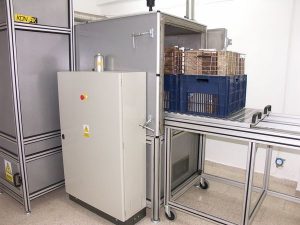 The fumigation chamber purchased by the Cieszyn Historical Library allows remote control of the disinfection process. The fumigation chamber purchased by the Cieszyn Historical Library allows remote control of the disinfection process.
|
 Efficient exhaust hood allows working with hazardous chemicals used for the conservation process. Efficient exhaust hood allows working with hazardous chemicals used for the conservation process.
|
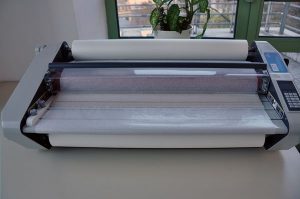 The laminating machine allows fusing damaged or weakened paper sheets (e.g. newspapers) into Japanese tissue and the effects of the operation can be reversed to isolate the laminated sheet if required. The laminating machine allows fusing damaged or weakened paper sheets (e.g. newspapers) into Japanese tissue and the effects of the operation can be reversed to isolate the laminated sheet if required. |
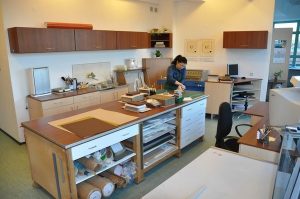 The interiors of the bookbinder’s workshop equipped with new furniture. In the back there is the electric paper cutter and the computer used for controlling the disinfection process in the fumigation chamber installed in the basement of the Cieszyn Historical Library. The interiors of the bookbinder’s workshop equipped with new furniture. In the back there is the electric paper cutter and the computer used for controlling the disinfection process in the fumigation chamber installed in the basement of the Cieszyn Historical Library. |
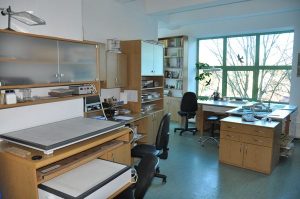 The interiors of the so-called „dry” conservation laboratory. On the left, there is the low-pressure mini-table and the under-pressure attachment. The interiors of the so-called „dry” conservation laboratory. On the left, there is the low-pressure mini-table and the under-pressure attachment. |
 The „wet” conservation laboratory. In the left bottom corner, there is the machine for filling sheet defects, bookbinding press in the center and the frame dryer on the right – purchased within the project. The „wet” conservation laboratory. In the left bottom corner, there is the machine for filling sheet defects, bookbinding press in the center and the frame dryer on the right – purchased within the project. |























